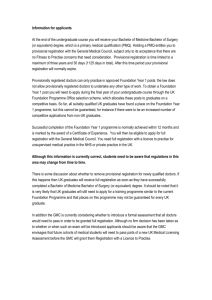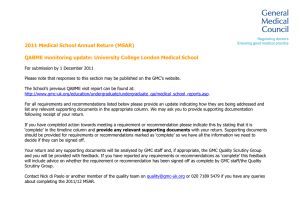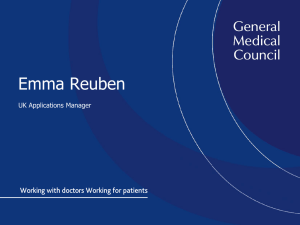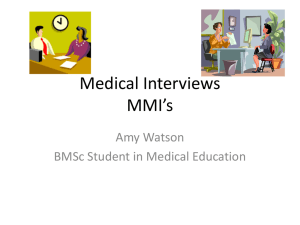Outcomes for graduates
advertisement
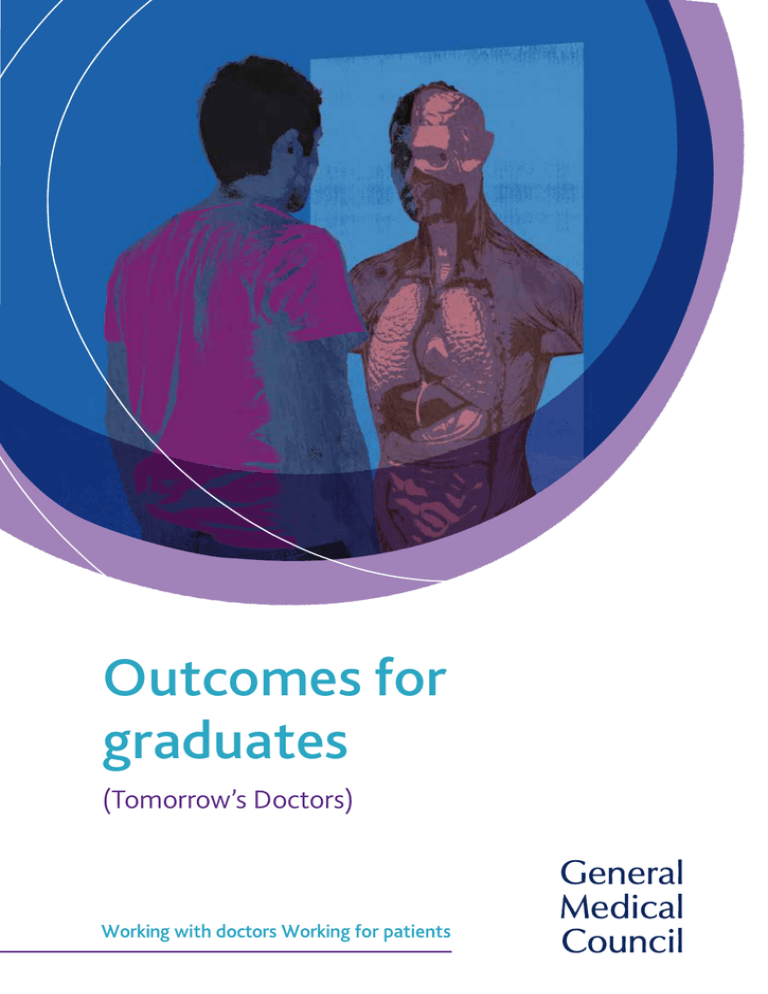
Outcomes for graduates (Tomorrow’s Doctors) Outcomes for graduates (Tomorrow’s Doctors) July 2015 About the outcomes for graduates The outcomes for graduates and the associated lists of practical procedures and related documents were originally published in Tomorrow’s Doctors (2009). Tomorrow’s Doctors also included standards for the delivery of teaching, learning and assessment which have been replaced by Promoting excellence: standards for medical education and training published in July 2015. Until we fully review the outcomes for graduates, we have kept the paragraph numbers used in the original version because these are referenced by other organisations. 1 Outcomes for graduates Overarching outcome for graduates 7 Medical students are tomorrow’s doctors. In accordance with Good medical practice, graduates will make the care of patients their first concern, applying their knowledge and skills in a competent and ethical manner and using their ability to provide leadership and to analyse complex and uncertain situations. Outcomes 1 − The doctor as a scholar and a scientist 8 The graduate will be able to apply to medical practice biomedical scientific principles, method and knowledge relating to: anatomy, biochemistry, cell biology, genetics, immunology, microbiology, molecular biology, nutrition, pathology, pharmacology and physiology. The graduate will be able to: a Explain normal human structure and functions. b Explain the scientific bases for common disease presentations. c Justify the selection of appropriate investigations for common clinical cases. d Explain the fundamental principles underlying such investigative techniques. e Select appropriate forms of management for common diseases, and ways of preventing common diseases, and explain their modes of action and their risks from first principles. f Demonstrate knowledge of drug actions: therapeutics and pharmacokinetics; drug side effects and interactions, including for multiple treatments, long term conditions and non-prescribed medication; and also including effects on the population, such as the spread of antibiotic resistance. g Make accurate observations of clinical phenomena and appropriate critical analysis of clinical data. 9 Apply psychological principles, method and knowledge to medical practice. a Explain normal human behaviour at an individual level. b Discuss psychological concepts of health, illness and disease. c Apply theoretical frameworks of psychology to explain the varied responses of individuals, groups and societies to disease. d Explain psychological factors that contribute to illness, the course of the disease and the success of treatment. 2 e Discuss psychological aspects of behavioural change and treatment compliance. f Discuss adaptation to major life changes, such as bereavement; comparing and contrasting the abnormal adjustments that might occur in these situations. g Identify appropriate strategies for managing patients with dependence issues and other demonstrations of self-harm. 10 Apply social science principles, method and knowledge to medical practice. a Explain normal human behaviour at a societal level. b Discuss sociological concepts of health, illness and disease. c Apply theoretical frameworks of sociology to explain the varied responses of individuals, groups and societies to disease. d Explain sociological factors that contribute to illness, the course of the disease and the success of treatment − including issues relating to health inequalities, the links between occupation and health and the effects of poverty and affluence. e Discuss sociological aspects of behavioural change and treatment compliance. 11 Apply to medical practice the principles, method and knowledge of population health and the improvement of health and healthcare. a Discuss basic principles of health improvement, including the wider determinants of health, health inequalities, health risks and disease surveillance. b Assess how health behaviours and outcomes are affected by the diversity of the patient population. c Describe measurement methods relevant to the improvement of clinical effectiveness and care. d Discuss the principles underlying the development of health and health service policy, including issues relating to health economics and equity, and clinical guidelines. e Explain and apply the basic principles of communicable disease control in hospital and community settings. f Evaluate and apply epidemiological data in managing healthcare for the individual and the community. g Recognise the role of environmental and occupational hazards in ill-health and discuss ways to mitigate their effects. 3 h Discuss the role of nutrition in health. i Discuss the principles and application of primary, secondary and tertiary prevention of disease. j Discuss from a global perspective the determinants of health and disease and variations in healthcare delivery and medical practice. 12 Apply scientific method and approaches to medical research. a Critically appraise the results of relevant diagnostic, prognostic and treatment trials and other qualitative and quantitative studies as reported in the medical and scientific literature. b Formulate simple relevant research questions in biomedical science, psychosocial science or population science, and design appropriate studies or experiments to address the questions. c Apply findings from the literature to answer questions raised by specific clinical problems. d Understand the ethical and governance issues involved in medical research. Outcomes 2 − The doctor as a practitioner 13 The graduate will be able to carry out a consultation with a patient: a Take and record a patient’s medical history, including family and social history, talking to relatives or other carers where appropriate. b Elicit patients’ questions, their understanding of their condition and treatment options, and their views, concerns, values and preferences. c Perform a full physical examination. d Perform a mental-state examination. e Assess a patient’s capacity to make a particular decision in accordance with legal requirements and the GMC’s guidance. f Determine the extent to which patients want to be involved in decision-making about their care and treatment. g Provide explanation, advice, reassurance and support. 14 Diagnose and manage clinical presentations. 4 a Interpret findings from the history, physical examination and mental-state examination, appreciating the importance of clinical, psychological, spiritual, religious, social and cultural factors. b Make an initial assessment of a patient’s problems and a differential diagnosis. Understand the processes by which doctors make and test a differential diagnosis. c Formulate a plan of investigation in partnership with the patient, obtaining informed consent as an essential part of this process. d Interpret the results of investigations, including growth charts, x-rays and the results of the diagnostic procedures in Appendix 1. e Synthesise a full assessment of the patient’s problems and define the likely diagnosis or diagnoses. f Make clinical judgements and decisions, based on the available evidence, in conjunction with colleagues and as appropriate for the graduate’s level of training and experience. This may include situations of uncertainty. g Formulate a plan for treatment, management and discharge, according to established principles and best evidence, in partnership with the patient, their carers, and other health professionals as appropriate. Respond to patients’ concerns and preferences, obtain informed consent, and respect the rights of patients to reach decisions with their doctor about their treatment and care and to refuse or limit treatment. h Support patients in caring for themselves. i Identify the signs that suggest children or other vulnerable people may be suffering from abuse or neglect and know what action to take to safeguard their welfare. j Contribute to the care of patients and their families at the end of life, including management of symptoms, practical issues of law and certification, and effective communication and teamworking. 15 Communicate effectively with patients and colleagues in a medical context. a Communicate clearly, sensitively and effectively with patients, their relatives or other carers, and colleagues from the medical and other professions, by listening, sharing and responding. b Communicate clearly, sensitively and effectively with individuals and groups regardless of their age, social, cultural or ethnic backgrounds or their disabilities, including when English is not the patient’s first language. 5 c Communicate by spoken, written and electronic methods (including medical records), and be aware of other methods of communication used by patients. The graduate should appreciate the significance of non-verbal communication in the medical consultation. d Communicate appropriately in difficult circumstances, such as when breaking bad news, and when discussing sensitive issues, such as alcohol consumption, smoking or obesity. e Communicate appropriately with difficult or violent patients. f Communicate appropriately with people with mental illness. g Communicate appropriately with vulnerable patients. h Communicate effectively in various roles, for example, as patient advocate, teacher, manager or improvement leader. 16 Provide immediate care in medical emergencies. a Assess and recognise the severity of a clinical presentation and a need for immediate emergency care. b Diagnose and manage acute medical emergencies. c Provide basic first aid. d Provide immediate life support. e Provide cardio-pulmonary resuscitation or direct other team members to carry out resuscitation. 17 Prescribe drugs safely, effectively and economically. a Establish an accurate drug history, covering both prescribed and other medication. b Plan appropriate drug therapy for common indications, including pain and distress. c Provide a safe and legal prescription. d Calculate appropriate drug doses and record the outcome accurately. e Provide patients with appropriate information about their medicines. f Access reliable information about medicines. g Detect and report adverse drug reactions. 6 h Demonstrate awareness that many patients use complementary and alternative therapies, and awareness of the existence and range of these therapies, why patients use them, and how this might affect other types of treatment that patients are receiving. 18 Carry out practical procedures safely and effectively. a Be able to perform a range of diagnostic procedures, as listed in Appendix 1 and measure and record the findings. b Be able to perform a range of therapeutic procedures, as listed in Appendix 1. c Be able to demonstrate correct practice in general aspects of practical procedures, as listed in Appendix 1. 19 Use information effectively in a medical context. a Keep accurate, legible and complete clinical records. b Make effective use of computers and other information systems, including storing and retrieving information. c Keep to the requirements of confidentiality and data protection legislation and codes of practice in all dealings with information. d Access information sources and use the information in relation to patient care, health promotion, giving advice and information to patients, and research and education. e Apply the principles, method and knowledge of health informatics to medical practice. Outcomes 3 − The doctor as a professional 20 The graduate will be able to behave according to ethical and legal principles. The graduate will be able to: a Know about and keep to the GMC’s ethical guidance and standards including Good medical practice, the ‘Duties of a doctor registered with the GMC’ and supplementary ethical guidance which describe what is expected of all doctors registered with the GMC. b Demonstrate awareness of the clinical responsibilities and role of the doctor, making the care of the patient the first concern. Recognise the principles of patient-centred care, including self-care, and deal with patients’ healthcare needs in consultation with them and, where appropriate, their relatives or carers. 7 c Be polite, considerate, trustworthy and honest, act with integrity, maintain confidentiality, respect patients’ dignity and privacy, and understand the importance of appropriate consent. d Respect all patients, colleagues and others regardless of their age, colour, culture, disability, ethnic or national origin, gender, lifestyle, marital or parental status, race, religion or beliefs, sex, sexual orientation, or social or economic status. Graduates will respect patients’ right to hold religious or other beliefs, and take these into account when relevant to treatment options. e Recognise the rights and the equal value of all people and how opportunities for some people may be restricted by others’ perceptions. f Understand and accept the legal, moral and ethical responsibilities involved in protecting and promoting the health of individual patients, their dependants and the public − including vulnerable groups such as children, older people, people with learning disabilities and people with mental illnesses. g Demonstrate knowledge of laws, and systems of professional regulation through the GMC and others, relevant to medical practice, including the ability to complete relevant certificates and legal documents and liaise with the coroner or procurator fiscal where appropriate. 21 Reflect, learn and teach others. a Acquire, assess, apply and integrate new knowledge, learn to adapt to changing circumstances and ensure that patients receive the highest level of professional care. b Establish the foundations for lifelong learning and continuing professional development, including a professional development portfolio containing reflections, achievements and learning needs. c Continually and systematically reflect on practice and, whenever necessary, translate that reflection into action, using improvement techniques and audit appropriately − for example, by critically appraising the prescribing of others. d Manage time and prioritise tasks, and work autonomously when necessary and appropriate. e Recognise own personal and professional limits and seek help from colleagues and supervisors when necessary. f Function effectively as a mentor and teacher including contributing to the appraisal, assessment and review of colleagues, giving effective feedback, and taking advantage of opportunities to develop these skills. 8 22 Learn and work effectively within a multi-professional team. a Understand and respect the roles and expertise of health and social care professionals in the context of working and learning as a multi-professional team. b Understand the contribution that effective interdisciplinary teamworking makes to the delivery of safe and high-quality care. c Work with colleagues in ways that best serve the interests of patients, passing on information and handing over care, demonstrating flexibility, adaptability and a problem-solving approach. d Demonstrate ability to build team capacity and positive working relationships and undertake various team roles including leadership and the ability to accept leadership by others. 23 Protect patients and improve care. a Place patients’ needs and safety at the centre of the care process. b Deal effectively with uncertainty and change. c Understand the framework in which medicine is practised in the UK, including: the organisation, management and regulation of healthcare provision; the structures, functions and priorities of the NHS; and the roles of, and relationships between, the agencies and services involved in protecting and promoting individual and population health. d Promote, monitor and maintain health and safety in the clinical setting, understanding how errors can happen in practice, applying the principles of quality assurance, clinical governance and risk management to medical practice, and understanding responsibilities within the current systems for raising concerns about safety and quality. e Understand and have experience of the principles and methods of improvement, including audit, adverse incident reporting and quality improvement, and how to use the results of audit to improve practice. f Respond constructively to the outcomes of appraisals, performance reviews and assessments. g Demonstrate awareness of the role of doctors as managers, including seeking ways to continually improve the use and prioritisation of resources. h Understand the importance of, and the need to keep to, measures to prevent the spread of infection, and apply the principles of infection prevention and control. 9 i Recognise own personal health needs, consult and follow the advice of a suitably qualified professional, and protect patients from any risk posed by own health. j Recognise the duty to take action if a colleague’s health, performance or conduct is putting patients at risk. 10 Appendix 1 – Practical procedures for graduates Diagnostic procedures Procedure Description in lay terms 1. Measuring body temperature ... using an appropriate recording device. 2. Measuring pulse rate and blood pressure ... using manual techniques and automatic electronic devices. 3. Transcutaneous monitoring of oxygen saturation Applying, and taking readings from, an electronic device which measures the amount of oxygen in the patient’s blood. 4. Venepuncture Inserting a needle into a patient’s vein to take a sample of blood for testing, or to give an injection into the vein. 5. Managing blood samples correctly Making sure that blood samples are placed in the correct containers, and that these are labelled correctly and sent to the laboratory promptly and in the correct way. Taking measures to prevent spilling and contamination. 6. Taking blood cultures Taking samples of venous blood to test for the growth of infectious organisms in the blood. Requires special blood containers and laboratory procedures. 7. Measuring blood glucose Measuring the concentration of glucose in the patient’s blood at the bedside, using appropriate equipment and interpreting the results. 8. Managing an electrocardiograph (ECG) monitor Setting up a continuous recording of the electrical activity of the heart. Ensuring the recorder is functioning correctly, and interpreting the tracing. 9. Performing and interpreting a 12-lead electrocardiograph Recording a full, detailed tracing of the electrical activity of the heart, using a (ECG) machine recorder (electrocardiograph). Interpreting the recording for signs of heart disease. 12 Procedure Description in lay terms 10. Basic respiratory function tests Carrying out basic tests to see how well the patient’s lungs are working (for example, how much air they can breathe out in one second). 11. Urine multi dipstick test Testing a sample of urine for abnormal contents, such as blood or protein. The urine is applied to a plastic strip with chemicals which change colour in response to specific abnormalities. 12. Advising patients on how to collect a mid-stream urine specimen Obtaining a sample of urine from a patient, usually to check for the presence specimen of infection, using a method which reduces the risk of contamination by skin bacteria. 13. Taking nose, throat and skin swabs Using the correct technique to apply sterile swabs to the nose, throat and skin. 14. Nutritional assessment Making an assessment of the patient’s state of nutrition. This includes an evaluation of their diet; their general physical condition; and measurement of height, weight and body mass index. 15. Pregnancy testing Performing a test of the urine to detect hormones which indicate that the patient is pregnant. 13 Therapeutic procedures Procedure Description in lay terms 16. Administering oxygen Allowing the patient to breathe a higher concentration of oxygen than normal, via a face mask or other equipment. 17. Establishing peripheral intravenous access and setting up an infusion; use of infusion devices Puncturing a patient’s vein in order to insert an indwelling plastic tube (known as a ‘cannula’), to allow fluids to be infused into the vein (a ‘drip’). Connecting the tube to a source of fluid. Appropriate choice of fluids and their doses. Correct use of electronic devices which drive and regulate the rate of fluid administration. 18. Making up drugs for parenteral administration Preparing medicines in a form suitable for injection into the patient’s vein. May involve adding the drug to a volume of fluid to make up the correct concentration for injection. 19. Dosage and administration of insulin and use of sliding scales Calculating how many units of insulin a patient requires, what strength of insulin solution to use, and how it should be given (for example, into the skin, or into a vein). Use of a ‘sliding scale’ which links the number of units to the patient’s blood glucose measurement at the time. 20. Subcutaneous and intramuscular injections Giving injections beneath the skin and into muscle. 21. Blood transfusion Following the correct procedures to give a transfusion of blood into the vein of a patient (including correct identification of the patient and checking blood groups). Observation for possible reactions to the transfusion, and actions if they occur. 22. Male and female urinary catheterisation Passing a tube into the urinary bladder to permit drainage of urine, in male and female patients. 14 Procedure Description in lay terms 23. Instructing patients in the use of devices for inhaled medication Providing instructions for patients about how to use inhalers correctly, for example, to treat asthma. 24. Use of local anaesthetics Using drugs which produce numbness and prevent pain, either applied directly to the skin or injected into skin or body tissues. 25. Skin suturing Repairing defects in the skin by inserting stitches (normally includes use of local anaesthetic). 26. Wound care and basic wound dressing Providing basic care of surgical or traumatic wounds and applying dressings appropriately. 27. Correct techniques for 'moving and handling', including patients Using, or directing other team members to use, approved methods for moving, lifting and handling people or objects, in the context of clinical care, using methods that avoid injury to patients, colleagues, or oneself. 15 General aspects of practical procedures Aspect Description in lay terms 28. Giving information about the procedure, obtaining and recording consent, and ensuring appropriate aftercare Making sure that the patient is fully informed, agrees to the procedure being performed, and is cared for and watched appropriately after the procedure. 29. Hand washing (including surgical ‘scrubbing up’) Following approved processes for cleaning hands before procedures or surgical operations. 30. Use of personal protective equipment (gloves, gowns, masks) Making correct use of equipment designed to prevent the spread of masks) body fluids or cross-infection between the operator and the patient. 31. Infection control in relation to procedures Taking all steps necessary to prevent the spread of infection before, during or after a procedure. 32. Safe disposal of clinical waste, needles and other ‘sharps’ Ensuring that these materials are handled carefully and placed in a suitable container for disposal. 16 Appendix 2 – Related documents GMC guidance 1 Good medical practice, 2013 2 Confidentiality, 2009 (under review in 2015) 3 Consent: patients and doctors making decisions together, 2008 (under review in 2015) 4 Consent to research, 2010 5 Good practice in prescribing and managing medicines and devices, 2013 6 Good practice in research, 2010 7 Personal beliefs and medical practice, 2013 8 Treatment and care towards the end of life: good practice in decision making, 2010 All at http://www.gmc-uk.org/guidance/index.asp Other documents 1 Academy of Medical Royal Colleges Intercollegiate Group on Nutrition. UK Undergraduate Curriculum in Nutrition (pdf). 2011. 2 The Education Committee of the Anatomical Society of Great Britain and Ireland. ‘A core syllabus in anatomy for medical students − Adding common sense to need to know’ (pdf). European Journal of Anatomy. 2007; 11 (Supplement 1): 3-18. 3 Association of American Medical Colleges and Howard Hughes Medical Institute. Scientific Foundation for Future Physicians (pdf). 2009. 4 Behavioural and Social Sciences Teaching in Medicine (BeSST). Psychology Core Curriculum for Undergraduate Medical Education (pdf). 2010. 5 British Geriatrics Society. Recommended Curriculum in Geriatric Medicine for medical undergraduates. 2013. 6 Centre for Sustainable Healthcare. Educating for Sustainable Healthcare - Priority Learning Outcomes. 2014. 7 von Fragstein M., Silverman J., Cushing A., Quilligan S., Salisbury H.,Wiskin C. ‘UK consensus statement on the content of communication curricula in undergraduate 17 medical education’ (pdf). Medical Education. 2008; 42:11:1100-1107. 8 Global Health Learning Outcomes Working Group. ‘Global health learning outcomes for medical students in the UK’. The Lancet. 2012; 379:9831:2033-2035. 9 Heads of Academic Departments of Public Health in the United Kingdom (HOADs) (original authors D Chappel, G Maudsley, R Bhopal and S Ebrahim, and re-edited by Stephen Gillam and Gillian Maudsley). Public Health Education for Medical Students – A guide for medical schools (pdf). Department of Public Health and Primary Care, University of Cambridge. 2008. 10 International Association for the Study of Pain. Curriculum outline on pain for medicine. 11 International Centre for Drug Policy. Substance Misuse in the Undergraduate Medical Curriculum (pdf). 2007. 12 Joint Committee on Medical Genetics. Learning Outcomes in Genetics for Medical Students (pdf). 2006. 13 Maxwell SRJ, Walley T. ‘Teaching safe and effective prescribing in UK Medical Schools: a core curriculum for tomorrow’s doctors’ (pdf). British Journal of Clinical Pharmacology. 2003; 55:496-503. 14 Medical Schools Council. Outcomes of the Medical Schools Council Safe Prescribing Working Group (pdf). 2007. 15 National Institute for Health and Clinical Excellence. Education, learning and professional development. 16 National Institute for Health and Clinical Excellence. Evidence search pages. 17 Royal College of Obstetricians and Gynaecologists. National Undergraduate Curriculum in Obstetrics and Gynaecology, Report of a Working Party (pdf). 2009. 18 Royal College of Ophthalmologists. Undergraduate Training in Ophthalmology. 2013. 19 Royal College of Psychiatrists. Report of the Royal College of Psychiatrists’ Scoping Group on Undergraduate Education in Psychiatry (pdf). 2009. 20 Royal College of Radiologists. Undergraduate Radiology Curriculum. 2012. 21 Royal College of Radiologists. Medical undergraduate non-surgical oncology curriculum. 2014 18 22 Scottish Deans’ Medical Education Group. The Scottish Doctor. Learning Outcomes for the Medical Undergraduate in Scotland: A Foundation for Competent and Reflective Practitioners. 2008. 23 Stirrat G M., Johnston C., Gillon R., et al. ‘Medical ethics and law for doctors of tomorrow: the 1998 Consensus Statement updated’. Journal of Medical Ethics. 2010, 36: 55-60. 24 The Tuning Project (Medicine). Learning Outcomes/Competences for Undergraduate Medical Education in Europe. Medical Education in Europe (MEDINE), the University of Edinburgh, Education and Culture DG of the European Commission, Tuning Educational Structures in Europe. 2008. 25 World Health Organisation World Alliance for Patient Safety. WHO Patient Safety Curriculum Guide for Medical Schools (pdf). World Health Organisation. 2009. 19 Email: gmc@gmc-uk.org Website: www.gmc-uk.org Telephone: 0161 923 6602 General Medical Council, 3 Hardman Street, Manchester M3 3AW Textphone: please dial the prefix 18001 then 0161 923 6602 to use the Text Relay service Join the conversation @gmcuk facebook.com/gmcuk linkd.in/gmcuk youtube.com/gmcuktv This information can be made available in alternative formats or languages. To request an alternative format, please call us on 0161 923 6602 or email us at publications@gmc-uk.org. © 2009 General Medical Council | Updated July 2015 The text of this document may be reproduced free of charge in any format or medium providing it is reproduced accurately and not in a misleading context. The material must be acknowledged as GMC copyright and the document title specified. ISBN:978-0-901458-72-8 Cover illustration by Geoff Hardie The GMC is a charity registered in England and Wales (1089278) and Scotland (SC037750) Code: GMC/OG(TD)/0715
